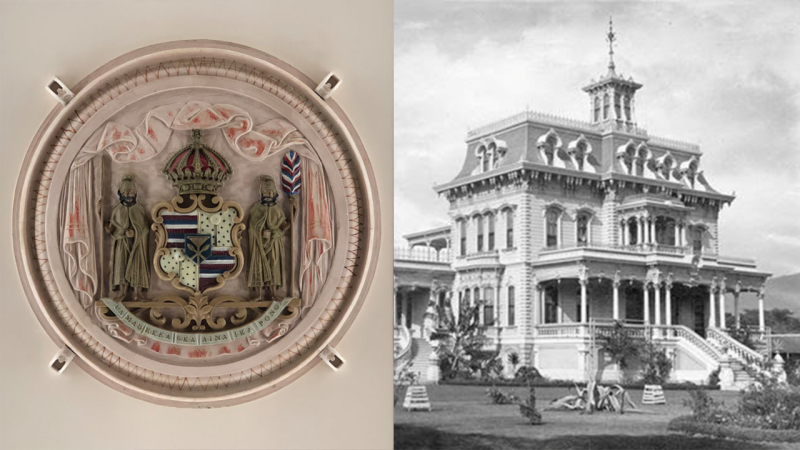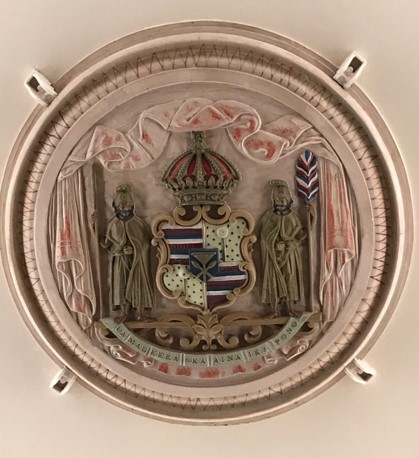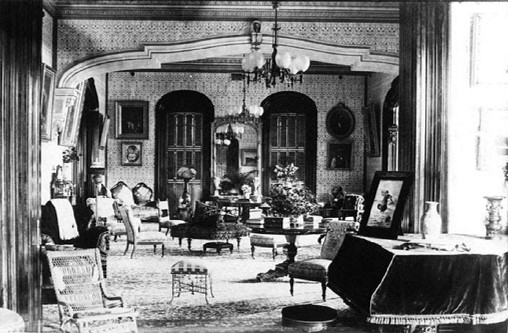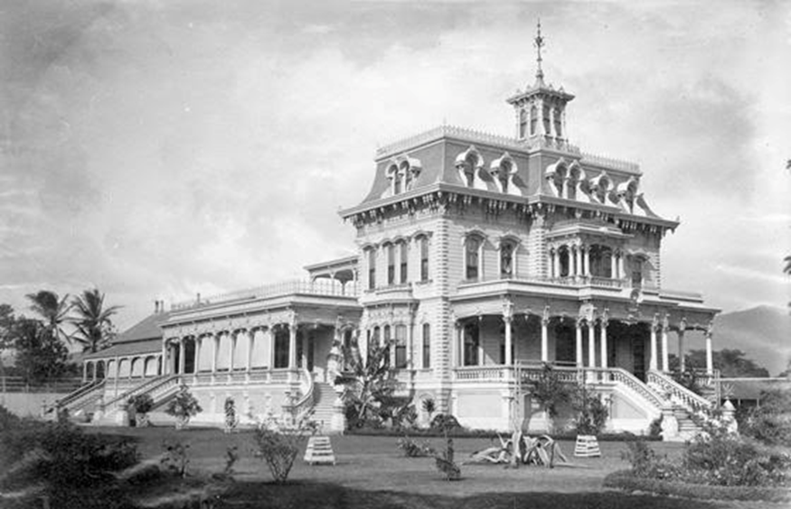Digital Collections
Celebrating the breadth and depth of Hawaiian knowledge. Amplifying Pacific voices of resiliency and hope. Recording the wisdom of past and present to help shape our future.
Nanea Armstrong-Wassel [Ho‘okahua]
BERNICE PAUAHI BISHOP HERITAGE CENTER - ENTRY ROOM
Coat of Arms of the Kingdom of Hawai‘i, c. 1880s
made of molded plaster; secured with clamps to ceiling; measuring 36” in diameter
This coat of arms was original to Keōua Hale, the home of Ruth Ke‘elikōlani which was bequeathed to Bernice Pauahi. It is one of four that were known to have decorated the grand ballroom.
The first version of the Hawaiian Coat of Arms came to be during the reign of Kauikeaouli, Kamehameha III. In July of 1842, he sent two emissaries, William Richards and Timoteo Ha‘alilio, to the United States and Europe on an official mission to negotiate formal treaties to recognize the Kingdom of Hawai‘i’s independence. While in London in 1843, Ha‘alilio, the King’s private secretary, submitted a design he had made to a professional engraver to create the formal seal. The design went through some changes before being officially adopted in 1845.
In the center of the coat of arms is a shield whose first and fourth quarters contain eight alternating white, red, and blue stripes, representative of the Hawaiian flag and the eight inhabited islands of the Kingdom. The second and third quarters contain a pūlo‘ulo‘u, a kapa-covered ball atop a stick (pahu) carried before a chief as an insignia of kapu. The pūlo‘ulo‘u is also a symbol of protection and refuge.
The triangular banner and crossed spears in the center of the shield also symbolize protection and kapu. The banner represents a puela, a narrow strip of kapa often flown above the sails of chiefly canoes as a marker of royal status.
The crown, ornamented with kalo leaves, symbolizes the monarchy and rests atop the shield. The two male figures dressed in ‘ahu ‘ula (feather cloaks) and mahiole (feathered helmets) are the sacred royal twin brothers, Kame‘eiamoku and Kamanawa. These two chiefs helped Kamehameha I come to power. One brother holds a spear while the other bears a feathered kāhili, a symbol of royalty.
The background of the coat of arms is meant to depict a draped ‘ahu ‘ula. Written on the sash at the bottom of the coat of arms is “Ua Mau ke Ea o ka ‘Āina i ka Pono,” the famous phrase spoken by Kauikeaouli when the sovereignty of the Kingdom was restored on July 31, 1843.
King Kalākaua revised the original version of the Hawaiian Coat of Arms by substituting the ‘ahu ‘ula with an ermine lined cape or robe, tasseled and fringed in gold. The Kalākaua version also included the addition of a second crown. This revised coat of arms first made its appearance on the reverse side of the Kalākaua silver dollar dated 1883.
Following the overthrow of the monarchy, the Provisional Government made their own modifications to the coat of arms. The crowns, puela, and crossed spears in the center were eliminated and replaced with eight stars and an eagle with outstretched wings.



